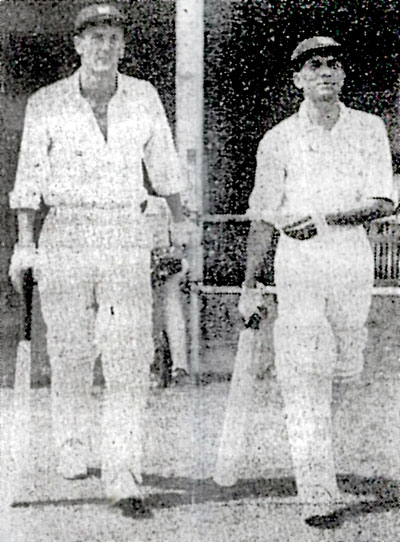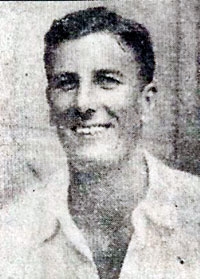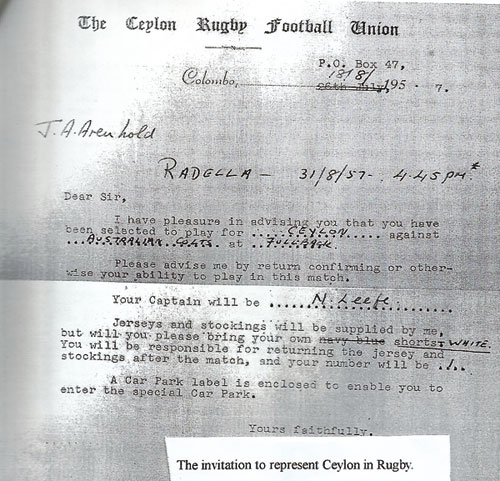John Arenhold – The South African rainbow in Ceylon Cricket and Rugby
Among those Season’s Greetings I received during the festive season were warm wishes from South Africa. It is from John Arenhold, the versatile South African sportsman who marvelled Sri Lanka’s sports fraternity in the mid 1950s. I felt joyous to hear from him after a lapse of a long period and especially, at a time when the Sri Lanka Cricket team is in South Africa.
 I haven’t seen him on the field. Yet, I have heard and read about his extraordinary sporting exploits. To date, I haven’t seen him personally. Yet, I have been privileged to correspond with him during the last 7 or 8 years, thanks to the efforts of Prof Heinrich Schulze of the University of South Africa.
I haven’t seen him on the field. Yet, I have heard and read about his extraordinary sporting exploits. To date, I haven’t seen him personally. Yet, I have been privileged to correspond with him during the last 7 or 8 years, thanks to the efforts of Prof Heinrich Schulze of the University of South Africa.
Arriving in Sri Lanka (then called Ceylon) in April 1956, Cape Town-born John Arenhold played Cricket for the Colombo Cricket Club (CCC) and Rugby for CH&FC, which were then considered exclusive preserve of the ‘Europeans’ residing in the island, and earned the privilege of representing Ceylon in both sports. Perhaps, he is the only South African double international in Ceylon Sport. He was a fast-medium opening bowler in Cricket, and played fly-half in Rugby, unbelievably, moving from his original position of prop forward at school level. He was also an excellent place kicker. According to “The Ceylon Fortnightly Review”, his arrival was a ‘great acquisition to Ceylon Sport’.
“I was proposed for membership for CCC and the CH&FC when I arrived in Ceylon, and I always found that we had excellent relationships with our opponents, both in Cricket and Rugby. I was impressed with the talent in opposition clubs, particularly, the CR in Rugby and of course, there were some very good cricketers around, and it was a pleasure being involved with them. Like many young expatriates there at that time, I was single. I do not recall any other South African sportsman in Sri Lanka then and, in fact, so far as I know, there were no South Africans at all,” he once wrote to me, answering one of my inquisitive questions.
John Arenhold, who studied at Cape Town University and later at Oxford University in England as a Rhodes Scholar, where he was awarded a Cricket “Blue”, came to Ceylon to work for Shell Company as a management trainee. By then, he had a high reputation as a top grade sportsman. Whilst at Oxford, he played Rugby for the Greyhounds and represented the University Cricket team in the County Championship from 1953 to 1955. In 1953, he was picked for the match against the visiting Australians and celebrated success in his very first over, when he clean bowled Colin McDonald for a ‘duck’. He also had the wicket of J.H. de Courcy who top scored for the visitors (142) at the Christ Church ground, Oxford. One of his cherished memories was the participation in the traditional Oxford-Cambridge encounter. It was the time when these two hallowed institutions played a major role in the British County Cricket competition. It not only produced many a promising cricketer over the years, but also the best of English cricketing brains. As he recalled: “I looked up the scorecard of the 1954 Varsity match at Lords, Colin (M.C. Cowdrey) won the toss and we batted – Oxford 401 for 3 declared. Mike (MJK) Smith 201 n.o., Colin Cowdrey 66 and 148 for 9 declared. Cambridge 344 for 9 dec. and 160 for 8 – match drawn. In the Oxford side, at least 7 of us played Test or 1st-Class Cricket, and about the same number in Cambridge. Gammie (Gamini Goonasena of Ceylon) took 6 for 71 in our 2nd Innings.” In the following year, whilst at Oxford, he had the rare opportunity of playing against the national team of his own country – South Africa! Then, in the same year, he was invited for D.R. Jardine’s XI to play against his own University – Oxford!! He was unplayable in that match, and not less than 7 Oxford University batsmen surrendered to him in the first innings, during his marathon spell of 27 overs.

John Arenhold
In Colombo, John Arenhold represented CCC in 1956 and was selected to play for All-Ceylon, when Polly Umrigar brought the full Indian Test side to Colombo, to take part in a 2-’Test’ series. It was the tail-end of the monsoon and, as expected, rain interfered with both games. Vernon Prins captained the All-Ceylon team in the first match and Gamini Goonasena in the second. The All-Ceylon team for the 2nd Test read: A.C.M. Lafir, C.H. Gunasekara, Clive Inman, C.I. Gunasekara, Gamini Goonasena, Anton Sethupathy, Bertie Wijesinha, Sathi Coomaswamy, John Arenhold, H.I.K. Fernando and G.P. Schoorman. Reminisced John Arenhold: “I was so pleased to meet up with Gammie (Gamini Goonasena) again, as we had played against each other in the 1954 Varsity match at Lords, when I was in Colin Cowdrey’s Oxford side. In the 2nd ‘Test’ Gammie and I batted together for quite a long time, and the partnership helped get us the draw. India had, arguably, the best leg spinner in the world at that time – Subash Gupte, who bowled a leg break and 3 different googlies off 3 different fingers, and with his sleeves rolled down!!! At the end of an over, early in our partnership, Gammie and I were chatting, and I said that I just couldn’t pick Gupte from the hand, and he said, “play every ball as a googly and when he gives you the leggie, you’ll miss it in any case!’ — Great advice and worth a laugh in a tense situation. In the first match I caught Vijay Manjrekar (Sanjay’s father) and the press said it was a pretty good effort!” According to the “The Times of Ceylon”: “Goonasena and Arenhold defied all the wiles of the Indian spin combination, on a wicket which rolled out less lively than it had been the previous day. Nevertheless, both Gupte and Ghulam Ahmed tried everything they knew to split this stand. But Goonasena and Arenhold, by the simple expedient of playing each individual ball on its merits, refused to be shifted. While Goonasena, quicker to spot Gupte’s spin as the ball left his hand, played mostly off the back foot; Arenhold preferred to play forward off a very long stretch.” It was during this period that Arenhold’s name featured regularly in sports pages of our local broadsheets.
In April 1957, John was selected to represent All-Ceylon team against the Madras Cricket Association in the Gopalan Trophy encounter. This annual cricket match between South India and Ceylon was considered at that time as the ‘big match’ in Ceylon cricket. The Englishmen, Australians and New Zealanders occasionally came and went figuring in a whistle-stop match or two, but it was the “Ceylon vs Madras” annual encounter that held a permanent spot in the local sports calendar. The South Indians in their 1st Innings, in the 1957 match, were shot out for 56, being the lowest in the series till then. No. 8 C. Chandy (ct. Clive Inman bld. Arenhold 15) was the only batsman to reach double figures. The chief wrecker was John Arenhold, with splendid figures of 11.3-7-17-6. H.C. Aldon’s All-Ceylon team replied with 140 (A.C.M. Lafir 21, C.H. Gunasekara 22, Clive Inman 55). In the 2nd Innings, the South Indians fared better and totalled 161, with Arenhold claiming 5 more wickets to his credit, which led to a 5-wicket victory for his team. Arenhold’s match bag of 11 for 43 was recorded as the best bowling performance for Sri Lanka, in the first phase of the Gopalan Trophy match history (1952-1983). The best being 12 for 108 by V.V. Kumar for Madras in 1957-58. Other notable bowling performances in the series were 11 for 137 by Daya Sahabandu (Ceylon) in 1968-69 and 11 for 140 by S. Venkatraghavan (Tamil Nadu) in 1974-75.
When I asked him about the Gopalan Trophy match performance, he replied: “To be honest, the wicket was a bit green, it was overcast and a great day for the bowlers. I was a bit lucky but, sorry, I can’t help being proud of those figures, and still have a ball with the analyses inscribed, on a plaque.”
From Cricket to Rugby: “Due to injury, I hadn’t played for a year or so, but Neville (Leefe) took me down to watch the CH practise late one afternoon and, my hands and feet just itched to be part of the game again. First though, I had to get a dentist to make me a plastic mouth-guard like a boxer. All rugby players use them now, but mine might have been unique in the 50’s and certainly, the only one in Ceylon! The CH&FC picked me for the first League game and that was it.”
History reveals that Colombo Football Club (1879) was the first Rugby club in Ceylon, and it amalgamated with the Colombo Hockey Club in 1896 to form the Colombo Hockey & Football Club (CH&FC). Although being the first Rugby club in the island and also studded wholly with expatriates since its inception, CH&FC were denied winning the premier inter-club League tournament and the Clifford Cup until 1957. Amazingly, that was the year John Arenhold joined the club.
CH&FC’s first match for the season was against Kandy SC, in which they emerged victorious by 32-0, with newcomer John Arenhold giving a “magnificent exhibition of kicking, both place and touch,” and Surrey-born flier Philip John Spark scoring 4 magnificent tries.
Thereafter, CH&FC defeated Uva 14-5, Havelocks 9-0, KV 29-0, drew with CR&FC and Havelocks (return match) but lost to the Dimbula-Dickoya Combined XV (Dim-Dicks) 3-16. Then came the CR-CH ‘return’ match which turned out to be the ultimate contest for the Low Country title. Although a mere draw would have been sufficient for the Longden Place club to enter the Clifford Cup final for the 6th successive year, CH&FC had to perform not only a match winning display, but also had to collect as many “Points For” to reserve a berth in the prestigious Cup Final. Finally, CH won the match, 10-3 and the Low-Country title. Apart from his safe collections and booming kicks, Arenhold also had two magnificent goal conversions to his credit.
Recalling those exciting moments, John wrote to me: “That second conversion right at the end of the game, for better goal average, was a nail-biter. In those days, the ball was held for the kicker by a teammate lying on the ground and, for me, it was always Neville. When I went over, Neville was on his feet shouting “we did it” and our celebration then would have put modern day Football players to shame!! For what remained of the game, I kicked the ball as far away from Longden Place as possible.”
 The 1957 Clifford Cup final was played at the picturesque Radella grounds between CH&FC and Dimbula-Dickoya (Dim-Dicks). Malcolm Wright led the home team. CH team had D.L.N. Knopp, P.G. Wynne-Evans, N. Wishart, Philip John Spark, M.E. Chilton, John Arenhold and Neville Leefe, Booth Smith, J. Lloyd, R. Kinniard, B.W. Foster, Peter Sawdy, St. John Davies (Capt.), Mike Wilson and N. Clayton. After a gruelling 60-minute contest the Race Course club- CH&FC clinched the island’s richest prize for Rugby supremacy for the first time in its history. CH&FC’s final tally of 11 points comprised of a try each by Neville Leefe and John Spark and a penalty and a conversion by John Arenhold. “The Sunday Times” went on to say that “CH owe their victory to Leefe and Arenhold, who were the heroes of the match.”
The 1957 Clifford Cup final was played at the picturesque Radella grounds between CH&FC and Dimbula-Dickoya (Dim-Dicks). Malcolm Wright led the home team. CH team had D.L.N. Knopp, P.G. Wynne-Evans, N. Wishart, Philip John Spark, M.E. Chilton, John Arenhold and Neville Leefe, Booth Smith, J. Lloyd, R. Kinniard, B.W. Foster, Peter Sawdy, St. John Davies (Capt.), Mike Wilson and N. Clayton. After a gruelling 60-minute contest the Race Course club- CH&FC clinched the island’s richest prize for Rugby supremacy for the first time in its history. CH&FC’s final tally of 11 points comprised of a try each by Neville Leefe and John Spark and a penalty and a conversion by John Arenhold. “The Sunday Times” went on to say that “CH owe their victory to Leefe and Arenhold, who were the heroes of the match.”
In August 1957 came the tour of the Australian RFU Colts team. John Arenhold not only represented the Ceylon team led by Neville Leefe in both “Tests” played at Radella (0-21) and Colombo (3-37), but also figured in the tour opener, for the Low-Country, which turned out to be a thriller. “The Ceylon Fortnightly Review” said: “John Arenhold, one of the most brilliant exponents of the Rugby Code Ceylon has had in my experience of over 50 years of Rugger in Ceylon, gave the mammoth gathering the feeling that he had reserved his most brilliant form for this memorable occasion. Not only did John save his side from early disaster, but his powerful kicking, perfectly directed and finding touch often to the extent of 30 or 40 yards, amazed the onlookers.”
A couple of weeks later, in the same 1957 season, Ceylon Rugby Football Union (CRFU) selected a strong team to represent All-Ceylon in the age-old All India Rugby tournament in Madras. Neville Leefe of CH&FC was picked to lead the team. The others were Kavan Rambukwelle, D. Madugalle, Ago Paiva, H. Aloysius, T. Anghie, R. Williams, B.M. Pay, P. Wynne-Evans, T.B. Pilapitiya, F. Kreltszhiem, P. Mahendran, D. Macrae, D. Rodrigo, D. Ephraims, R. Trewin, Clayton, D. Frank and also the South Africa born John Arenhold. As the team was about to leave the island, CRFU was informed that the hosts were not happy having a South African in the tour party. According to John Arenhold, “It was the All India Rugby tournament in Madras was the problem, as we had played the Gopalan Trophy at home in Colombo. The Indians, probably, quite rightly, for political reasons, in view of the South Africa’s colour policy, didn’t want an ordinary South African whoever he was, in their country. So we had a problem, because the CRFU wanted me at fullback. I don’t really know the details, but I believe it was that wonderful man Noel Gratiaen, along with Teddy Ewart and the Union President, had a few words with Sir Oliver Goonatillake, the Governor General, who eloquently pleaded our case and I was allowed in on a very limited basis – play Rugby and behave yourself!” He further added, “In Madras, we had gone flat as a team and I don’t know why, may be as amateurs, we had played a lot of Rugby, and were a bit jaded. Nevertheless, all credit to the South Indians (they beat All Ceylon 8-3) and my old Oxford friend Harry Joynt (fullback and place kicker of the South India team), on winning.”


